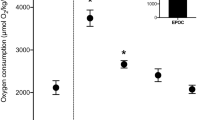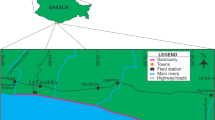Abstract
Odontocetes have an exceptional range in body mass spanning 103 kg across species. Because, size influences oxygen utilization and carbon dioxide production rates in mammals, this lineage likely displays an extraordinary variation in oxygen store management compared to other marine mammal groups. To examine this, we measured changes in the partial pressures of respiratory gases (\( P_{{{\text{O}}_{2} }} \), \( P_{{{\text{CO}}_{2} }} \)), pH, and lactate in the blood during voluntary, quiescent, submerged breath holds in Pacific white-sided dolphins (Lagenorhynchus obliquidens), bottlenose dolphins (Tursiops truncatus), and a killer whale (Orcinus orca) representing a mass range of 96–3,850 kg. These measurements provided an empirical determination of the effect of body size on the variability in blood biochemistry during breath hold and experimentally determined aerobic dive limits (ADL) within one taxonomic group (odontocetes). For the species in this study, maximum voluntary breath-hold duration was positively correlated with body mass, ranging from 3.5 min in white-sided dolphins to 13.3 min for the killer whale. Variation in breath-hold duration was associated with differences in the rate of change for \( P_{{{\text{O}}_{2} }} \) throughout breath hold; \( P_{{{\text{O}}_{2} }} \) decreased twice as fast for the two smaller species (−0.6 mmHg O2 min−1) compared to the largest species (−0.3 mmHg O2 min−1). In contrast, the rate of increase in \( P_{{{\text{CO}}_{2} }} \) during breath hold was similar across species. These results demonstrate that large body size in odontocetes facilitates increased aerobic breath-hold capacity as mediated by decreased mass-specific metabolic rates (rates of change in \( P_{{{\text{O}}_{2} }} \) served as a proxy for oxygen utilization). Indeed the experimentally determined 5 min ADL for bottlenose dolphins was surpassed by the 13.3 min maximum breath hold of the killer whale, which did not end in a rise in lactate. Rather, breath hold ended voluntarily as respiratory gases and pH fell within a narrow range for both large and small species, likely providing cues for ventilation.



Similar content being viewed by others
References
Black NA (1994) Behavior and ecology of Pacific white-sided dolphins (Lagenorhynchus obliquidens) in Monterey Bay, California. M.S. Thesis, San Francisco State University, San Francisco, CA
Boutilier RG, Reed JZ, Fedak MA (2001) Unsteady-state gas exchange and storage in diving marine mammals: the harbor porpoise and gray seal. Am J Physiol Regulatory Integrative Comp Physiol 281:R490–R494
Boyd IL, Croxall JP (1996) Dive durations in pinnipeds and seabirds. Can J Zool 74:1696–1705
Butler PJ (1982) Respiratory and cardiovascular control during diving in birds and mammals. J Exp Biol 100:195–221
Castellini MA, Kooyman GL, Ponganis PJ (1992) Metabolic rates of freely diving weddell seals: correlations with oxygen stores, swim velocity and diving duration. J Exp Biol 165:181–194
Costa DP (1991) Reproductive and foraging energetics of high latitude penguins, albatrosses and pinnipeds: implications for life history patterns. Am Zool 31:11–130
Costa DP, Gales NJ, Crocker DE (1998) Blood volume and diving ability of the New Zealand sea lion, Phocarctos hookeri. Physiol Zool 71(2):208–213
Costa DP, Kuhn CE, Weise MJ, Shaffer SA, Arnould JPY (2004) When does physiology limit the foraging behaviour of freely diving mammals? Int Congr Ser 1275:359–366
Craig AB, Pasche A (1980) Respiratory physiology of freely diving harbor seals (Phoca vitulina). Physiol Zool 53:419–432
Evans PGH (1987) The natural history of whales and dolphins. Facts on File, Inc, New York, p 343
Ferretti C, Costa M, Ferrigno M, Grassi B, Marconi C, Lundgren CEG, Cerretelli P (1991) Alveolar gas composition and exchange during deep breath-hold diving and dry breath holds in elite divers. J Appl Physiol 70:794–802
Ferrigno M, Lundgren CE (2003) Breath-hold diving. In: Brubakk AO, Neuman TS (eds) Physiology and medicine of diving. Saunders, Edinburgh, pp 153–180
Gallivan GJ (1980) Hypoxia and hypercapnia in the respiratory control of the Amazonian manatee (Trichechus inunguis). Physiol Zool 53:254–261
Goforth HW (1986) Glycogenetic responses and force production characteristics of a bottlenose dolphin (Tursiops truncatus) while exercising against a force transducer. Ph.D. Thesis. University of California, Los Angeles
Gordos MA, Franklin CE, Limpus CJ, Wilson G (2004) Blood-respiratory and acid–base changes during extended diving in the bimodally respiring freshwater turtle Rheodytes leukops. J Comp Physiol B 174:347–354
Hedrick MS, Duffield DA (1991) Haematological and rheological characteristics of blood in seven marine mammal species: physiological implications for diving behavior. J Zool Lond 225:273–283
Heyning JE, Dahlheim ME (1988) Orcinus orca. Mamm Species 304:1–9
Hudson DM, Jones DR (1986) The influence of body mass on the endurance to restrained submergence in the Pekin duck. J Exp Biol 120:351–367
Johansen K, Lenfant C, Grigg GC (1966) Respiratory properties of blood and responses to diving of the platypus ornithorhynchus anatinus (shaw). Comp Biochem Physiol 18:597–608
Kleiber M (1975) The fire of life: an introduction to animal energetics. R.E. Krieger Publ. Co, Huntington, p 453
Kooyman GL (1989) Diverse Divers. Springer-Verlag Berlin Heidelberg, Germany
Kooyman GL, Ponganis PJ (1998) The physiological basis of diving to depth: birds and mammal. Annu Rev Physiol 60:19–32
Kooyman GL, Kerem DH, Campbell WB, Wright JJ (1971) Pulmonary function in freely diving Weddell seal, Leptonychotes weddellii. Respir Physiol 12:271–282
Kooyman GL, Wahrenbrock EA, Castellini MA, Davis RW, Sinnett EE (1980) Aerobic and anaerobic metabolism during voluntary diving in Weddell seals: evidence for preferred pathways from blood chemistry and behavior. J Comp Physiol B 138:335–346
Kooyman GL, Castellini MA, Davis RW, Mave RA (1983) Aerobic diving limits of immature Weddell seals Leptonychotes weddellii. J Comp Physiol B 151:171–174
Martin AR, Smith TG, Cox OP (1993) Studying the behaviour and movements of high Arctic belugas with satellite telemetry. Symp Zool Soc Lond 66:195–210
Meir JU, Champagne CD, Costa DP, Williams CL, Ponganis PJ (2009) Extreme hypoxemic tolerance and blood oxygen depletion in diving elephant seals. Am J Physiol Regul Intergr Comp Physiol 297:R927–R939
Nagy K (1994) Field bioenergetics of mammals: what determines field metabolic rate? Aust J Zool 42:43–53
Noren SR (2004) Muscle acid buffering capacities in cetaceans: influences of diving performance, swimming performance, body size, and postpartum development. Mar Mamm Sci 20(4):808–822
Noren SR, Williams TM (2000) Body size and skeletal muscle myoglobin of cetaceans: adaptations for maximizing dive duration. Comp Biochem Physiol 126(A):181–191
Noren SR, Lacave G, Wells RS, Williams TM (2002) The development of blood oxygen stores in bottlenose dolphins (Tursiops truncatus): implications for diving capacity. J Zool Lond 258:105–113
Noren SR, Cuccurullo V, Williams TM (2004) The development of diving bradycardia in bottlenose dolphins (Tursiops truncatus). J Comp Physiol B 174:139–147
Noren SR, Iverson SJ, Boness DJ (2005) Development of the blood and muscle oxygen stores in grey seals (Halichoerus grypus): implications for juvenile diving capacity and the necessity of a terrestrial postweaning fast. Physiol Biochem Zool 78(4):482–490
Pasche A (1976a) Hypoxia in freely diving hooded seal, Cystophora cristata. Comp Biochem Physiol 55A:319–322
Pasche A (1976b) The effect of hypercapnia on respiratory characteristics and diving behaviour of freely diving seals. Respir Physiol 26:183–194
Phillipson EA, Duffin J, Cooper JD (1981) Critical dependence of respiratory rhythmicity on metabolic CO2 load. J Appl Physiol 50:45–55
Piiper J (1990) Modeling of gas exchange in lungs, gills and skin. In: Boutilier RG (ed) Advances in comparative and environmental physiology, vol 6. Springer Verlag, Berlin, pp 15–44
Ponganis PJ, Kooyman GL, Castellini MA (1993) Determinants of the aerobic dive limit of Weddell seals: analysis of diving metabolic rates, postdive end tidal PO2’s and blood and muscle oxygen stores. Physiol Zool 66:732–749
Ponganis PJ, Kooyman GL, Baranov EA, Thorson PH, Steward BS (1997a) The aerobic submersion limit of Baikal seals, Phoca sibirica. Can J Zool 75:1323–1327
Ponganis PJ, Kooyman GL, Winter LM, Starke LN (1997b) Heart rate and plasma lactate responses during submerged swimming and trained diving in California sea lions, Zalophus californianus. J Comp Physiol 167:9–16
Ponganis PJ, Stockard TK, Meir JU, Williams CL, Ponganis KV, van Dam RP, Howard R (2007) Returning on empty: extreme blood O2 depletion underlies dive capacity of emperor penguins. J Exp Biol 210:4279–4285
Ponganis PJ, Meir JU, Williams CL (2010) Oxygen store depletion and the aerobic dive limit in emperor penguins. Aquat Biol 8:237–245
Qvist J, Hill RD, Schneider RC, Falke KJ, Liggins GC, Guppy M, Elliott RL, Hochachaka PW, Zapol WM (1986) Hemoglobin concentrations and blood gas tensions of free-diving Weddell seals. J Appl Physiol 61:1560–1569
Ridgway SH (1972) Mammals of the sea biology and medicine. Charles C Thomas Publisher, Springfield
Ridgway SH, Harrison RJ (1986) Diving dolphins. In: Bryden MM, Harrison RJ (eds) Research on dolphins. Clarendon Press, Oxford, pp 33–58
Ridgway SH, Johnston DG (1966) Blood oxygen and ecology of porpoises of three genera. Science 151:456–457
Ridgway SH, Scronce BL, Kanwisher J (1969) Respiration and deep diving in the bottlenose porpoise. Science 166:1651–1654
Ridgway SH, Bowers CA, Miller D, Schultz ML, Jacobs CA, Dooley CA (1984) Diving and blood oxygen in the white whale (Delphinapterus leucas). Can J Zool 62:2349–2351
Schreer JF, Kovacs KM (1997) Allometry of diving capacity in air-breathing vertebrates. Can J Zool 75:339–358
Shaffer SA, Costa DP, Williams TM, Ridgway SH (1997) Diving and swimming performance of white whales, Delphinapterus leucas: an assessment of plasma lactate and blood gas levels and respiratory rates. J Exp Biol 200:3091–3099
Stockard TK, Levenson DH, Berg L, Fransioli JR, Baranov EA, Ponganis PJ (2007) Blood oxygen depletion during rest-assoicated apneas of northern elephant seals (Mirounga angustirostris). J Exp Biol 210:2607–2617
Watkins WA, Daher MA, Fristrup KM, Howard TJ, Di Sciara GN (1993) Sperm whales tagged with transponders and tracked underwater by sonar. Mar Mamm Sci 9(1):55–67
Westgate AJ, Read AJ, Berggren P, Koopman HN, Gaskin DE (1995) Diving behaviour of harbour porpoise, Phocoena phocoena. Can Fish Aquat Sci 52:1064–1073
Williams TM, Friedl WA, Fong ML, Yamada RM, Sedivy P, Haun JE (1992) Travel at low energetic cost by swimming and wave-riding bottlenose dolphins. Nature 355:821–823
Williams TM, Friedl WA, Haun JE (1993a) The physiology of bottlenose dolphins (Tursiops truncatus): heart rate, metabolic rate, and plasma lactate concentration during exercise. J Exp Biol 179:31–46
Williams TM, Friedl WA, Haun JE, Chun NK (1993b) Balancing power and speed in bottlenose dolphins (Tursiops truncatus). Symp Zool Soc Lond 66:383–394
Williams TM, Haun JE, Friedl WA (1999) The diving physiology of bottlenose dolphins (Tursiops truncatus) I. Balancing the demands of exercise for energy conservation at depth. J Exp Biol 202:2739–2748
Williams TM, Haun J, Davis RW, Fuiman LA, Kohin S (2001) A killer appetite: metabolic consequences of carnivory in marine mammals. Comp Biochem Physiol A 129(4):785–796
Williams TM, Noren SR, Glenn M (2011) Extreme physiological adaptations as predictors of climate-change sensitivity in the narwhal, Monodon monoceros. Mar Mamm Sci 27(2):334–349
Acknowledgments
We thank the staff and animals at John G. Shedd Aquarium, Oregon Coast Aquarium and Free Willy Keiko Foundation, and Naval Ocean Systems Center; this work would not have been possible without them. We thank D.P. Noren for assistance with the Pacific white-sided dolphin study. This study was funded by: Office of Naval Research Marine Mammal Program award #N00014-00-1-0761 to T.M. Williams, Shedd Aquarium Aquatic Science Partnerships Program supported by Dr. Scholl Foundation awarded to T.M. Williams and S.R. Noren, Lerner-Gray Fund for Marine Research from American Museum of Natural History awarded to S.R Noren, and American Cetacean Society (Monterey Bay Chapter Grant) awarded to S.R. Noren. All materials and methods and all experiments comply with the current laws of the United States of America and were approved by the Chancellor’s Animal Research Committee of the University of California at Santa Cruz.
Author information
Authors and Affiliations
Corresponding author
Additional information
Communicated by H.V. Carey.
Electronic supplementary material
Below is the link to the electronic supplementary material.
Rights and permissions
About this article
Cite this article
Noren, S.R., Williams, T.M., Ramirez, K. et al. Changes in partial pressures of respiratory gases during submerged voluntary breath hold across odontocetes: is body mass important?. J Comp Physiol B 182, 299–309 (2012). https://doi.org/10.1007/s00360-011-0612-0
Received:
Revised:
Accepted:
Published:
Issue Date:
DOI: https://doi.org/10.1007/s00360-011-0612-0




